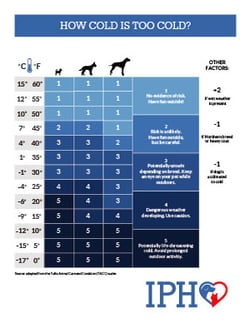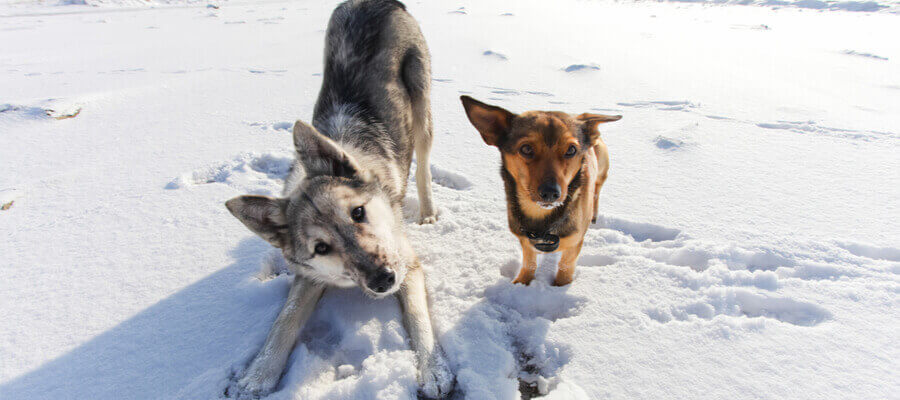As a dog owner, it’s important to understand the differences between what you can handle versus what your dog can handle. For example, just because your dog is covered in fur doesn’t mean that they can handle cold weather better than you. Bigger dogs are better at coping with low temperatures outside than little dogs are, but even they are still at risk. In this blog, we’ll cover what temperatures different-sized dogs can handle and which ones are potentially dangerous, as well as how to identify the symptoms of hypothermia and gauge the need for a visit to the vet.
How Cold is Too Cold for Your Dog?
 Which temperatures your dog can handle mostly depends on their size, although there are other outlying factors as well such as breed, if the dog is wet or dry and if the dog is acclimated to the cold. We’ve created this infographic to give you an at-a-glance look at the stats collected by Tufts Animal Care and Condition (TACC).
Which temperatures your dog can handle mostly depends on their size, although there are other outlying factors as well such as breed, if the dog is wet or dry and if the dog is acclimated to the cold. We’ve created this infographic to give you an at-a-glance look at the stats collected by Tufts Animal Care and Condition (TACC).
We’ll cover these stats in a little more detail. We highly recommend installing your own outdoor thermostat to ensure you have an accurate idea of the temperature in your own yard, not just in your general area, as it can differ depending on elevation, wind patterns, and other factors.
Temperature Safety for Small Dogs
Small dogs are the most susceptible to colder temperatures and have the greatest risk of hypothermia. Keep these temperature safety guidelines in mind when sending your dog outside:
- 50-60 degrees and higher are safe temperatures for your dog. 85+ degree temperatures are a different beast in itself, but we’re just talking about cool to cold temperatures here.
- 45 degrees or so are generally acceptable, but you’ll still want to keep an eye on how your dog is handling itself in these temperatures.
- 30-40 degrees is potentially unsafe for your dog, depending on what breed. If they are a Northern breed or have a heavy coat, they are likely okay outside. Think of a chihuahua versus a Havanese or Maltese.
- 25 degrees is when you start dipping into dangerous weather, so you’ll want to use caution, especially if your dog has already shown sensitivity to warmer weather than this.
- 20 degrees and lower is where you reach potentially life-threatening cold weather. Keep your dog indoors as much as possible and avoid any prolonged activity outdoors.
Temperature Safety for Medium-sized Dogs
Medium-sized dogs have a lot in common with small dogs when it comes to their ability to handle certain temperatures. The only difference that has been noted is that they have more potential to function better than small dogs do in 15-20 degree weather. However, this is still dangerous and depends on what breed of dog you have, so you’ll want to use caution.
Temperature Safety for Large Dogs
Large dogs do best in the cold compared to the other sizes. Here are some ideas of what they can handle:
- At 45 degrees and higher, there is no risk for large dogs to be outdoors. They can play outside until their hearts are content!
- Around 40 degrees, risk is unlikely but can depend on the breed of your dog. Generally, you’re safe.
- 20-35 degrees is where large dogs need to have eyes on them, as these are potentially unsafe conditions depending on your dog’s breed and unique needs.
- 15 degrees and lower is where you hit a danger zone, so you’ll want to really limit your dog’s exposure to the elements and keep them indoors as much as possible.
Identifying Hypothermia in Your Dog
The great rule to follow should always be: When in doubt, keep your dog indoors. The last thing you want to do is put your precious pet in danger of getting frostbite or hypothermia. Depending on the severity, symptoms of hypothermia can include:
- Weakness
- Shivering
- Inaudible heartbeat
- Trouble breathing
If your pet experiences any of these symptoms after being out in the cold, it’s important that you give your vet a call right away. Keep your pet in a warm area and cover them with warm blankets/towels (avoid using heating pads, as these can burn your pet). Then take your dog to the vet as soon as possible.
If you live in Boise and your dog is sitting out in the cold all day while you’re gone, or you’re concerned that your furry friend is lonely in the house, it’s time to look into Doggy Daycare or our Pet Lodge. We’ll take the best care of your furry best friend, and they’ll come home to you warm and happy! No frostbite or hypothermia here- no, sir. Contact us to learn more about how we can ensure your pet is safe and warm this winter.

